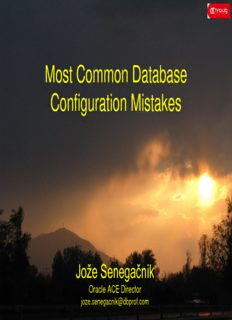
Most Common Database Configuration Mistakes PDF
Preview Most Common Database Configuration Mistakes
DbProf. com Most Common Database Configuration Mistakes Jože Senegačnik Oracle ACE Director [email protected] www.dbprof.com - © 2014 - Jože Senegačnik 1 DbProf. com About the Speaker Jože Senegačnik • First experience with Oracle Version 4 in 1988 • 26 years of experience with Oracle RDBMS. • Proud member of the OakTable Network www.oaktable.net • Oracle ACE Director • Co-author of the OakTable book “Expert Oracle Practices” by Apress (Jan 2010) • VP of Slovenian OUG (SIOUG) board • CISA – Certified IS auditor • Blog about Oracle: http://joze-senegacnik.blogspot.com • PPL(A) – private pilot license PPL(A) / instrument rated IR/SE • Blog about flying: http://jsenegacnik.blogspot.com • Blog about Building Ovens, Baking and Cooking: http://senegacnik.blogspot.com www.dbprof.com - © 2014 - Jože Senegačnik 2 DbProf. com Agenda • The growth of the size of databases, multi-tier architecture and big numbers of end users are creating new threat for proper configuration. – Connection Configuration – Memory Configuration • The hardware is getting more and more powerful (a lot of CPUs), server’s memory is measured in terabytes what makes people so comfortable about performance that they make huge mistakes in proper application development. – Bad Application Design / Coding www.dbprof.com - © 2014 - Jože Senegačnik 3 DbProf. com Connection Management www.dbprof.com - © 2014 - Jože Senegačnik 4 DbProf. com Inadequate Configured Middle Tier • Poor connection pool strategy – High number connections to the database (1,000s) – Dynamic connection pool with a large number of logon/logoff to the database ( >1/Sec) – Periods of unexplainable/undebuggable poor performance/availability – Inability to determine what is going wrong • Logon process one of the most complex in Oracle database (disconnect is even more) www.dbprof.com - © 2014 - Jože Senegačnik 5 DbProf. com Concurrent Mid-Tier Connections 2000 1000 • Too many concurrent sessions sessions sessions introduce contention and decrease performance • Significantly reduced number of sessions increases throughput • Database level is not the right level for queueing. 96 sessions Source: OLTP Performance - Concurrent Mid-Tier Connections – Oracle Real World performance group http://www.youtube.com/watch?v=xNDnVOCdvQ0 www.dbprof.com - © 2014 - Jože Senegačnik 6 DbProf. com Connection Pool Configuration • Properly size the connection pools - the hardest thing to convince customers • Minimum = Maximum • More sessions mean potentially more contention for same resources. • Don‘t allow the spiral dive by creating new connections due to bad database response time – this will just increase the response time. • Middle tier is the place for queueing, not database! www.dbprof.com - © 2014 - Jože Senegačnik 7 DbProf. com Questionable Values of Init. Parameters • processes = 30,000 per Exadata node • sessions = 45,024 per Exadata node • Consequence: – Huge SGA internal tables (X$ tables are actually exposed C- structures) – Process/Session internal tables are fixed arrays – they are created at instance startup – The above numbers are totaly un-realistic www.dbprof.com - © 2014 - Jože Senegačnik 8 DbProf. com Another System With Same Problems • > 40,000 online application users • Middle tier ~100 application servers – Application written in Java • Periods of performance problems with high wait times – most of them were not explainable • 2-node RAC with 128 CPU-s per node • 35,000 sessions per instance (70,000 overall) • Spiral dive when response time was bad due to increased number of connections www.dbprof.com - © 2014 - Jože Senegačnik 9 DbProf. com Memory Confuguration www.dbprof.com - © 2014 - Jože Senegačnik 10
Description: